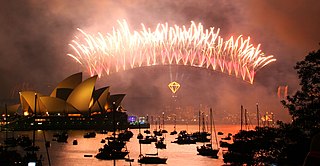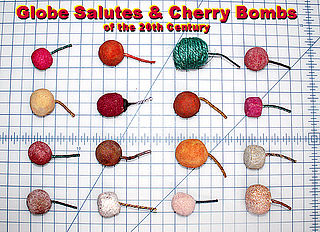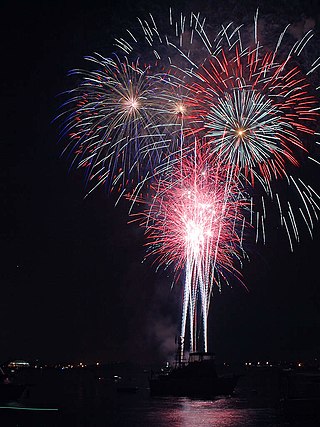Related Research Articles

Fireworks are low explosive pyrotechnic devices used for aesthetic and entertainment purposes. They are most commonly used in fireworks displays, combining a large number of devices in an outdoor setting. Such displays are the focal point of many cultural and religious celebrations, though mismanagement could lead to fireworks accidents.

Pyrotechnics is the science and craft of creating such things as fireworks, safety matches, oxygen candles, explosive bolts and other fasteners, parts of automotive airbags, as well as gas-pressure blasting in mining, quarrying, and demolition. This trade relies upon self-contained and self-sustained exothermic chemical reactions to make heat, light, gas, smoke and/or sound. The name comes from the Greek words pyr ("fire") and tekhnikos.

A skyrocket is a type of firework that uses a solid-fuel rocket to rise quickly into the sky; a bottle rocket is a small skyrocket. At the apex of its ascent, it is usual for a variety of effects to be emitted. Skyrockets use various stabilisation techniques to ensure the flight follows a predictable course, often a long stick attached to the side of the motor, but also including spin-stabilisation or fins.

A firecracker is a small explosive device primarily designed to produce a large amount of noise, especially in the form of a loud bang, usually for celebration or entertainment; any visual effect is incidental to this goal. They have fuses, and are wrapped in a heavy paper casing to contain the explosive compound. Firecrackers, along with fireworks, originated in China.

A Roman candle is a traditional type of firework that ejects one or more stars or exploding shells. Roman candles come in a variety of sizes, from 6 mm (0.24 in) diameter for consumers, up to 8 cm (3.1 in) diameter in professional fireworks displays.

Smokeless powder is a type of propellant used in firearms and artillery that produces less smoke and less fouling when fired compared to black powder. Because of their similar use, both the original black powder formulation and the smokeless propellant which replaced it are commonly described as gunpowder. The combustion products of smokeless powder are mainly gaseous, compared to around 55% solid products for black powder. In addition, smokeless powder does not leave the thick, heavy fouling of hygroscopic material associated with black powder that causes rusting of the barrel.

Potassium perchlorate is the inorganic salt with the chemical formula KClO4. Like other perchlorates, this salt is a strong oxidizer when the solid is heated at high temperature although it usually reacts very slowly in solution with reducing agents or organic substances. This colorless crystalline solid is a common oxidizer used in fireworks, ammunition percussion caps, explosive primers, and is used variously in propellants, flash compositions, stars, and sparklers. It has been used as a solid rocket propellant, although in that application it has mostly been replaced by the more performant ammonium perchlorate.

Flash powder is a pyrotechnic composition, a mixture of oxidizer and metallic fuel, which burns quickly (deflagrates) and produces a loud noise regardless of confinement. It is widely used in theatrical pyrotechnics and fireworks and was once used for flashes in photography.

A cherry bomb is an approximately spherical exploding firework, roughly resembling a cherry in size and shape. Cherry bombs range in size from three-quarters to one and a half inches in diameter.
Armstrong's mixture is a highly shock and friction sensitive primary explosive. Formulations vary, but one consists of 67% potassium chlorate, 27% red phosphorus, 3% sulfur, and 3% calcium carbonate. It is named for Sir William Armstrong, who invented it sometime prior to 1872 for use in explosive shells.

A quarter stick, colloquially known as the M-1000, is a large firecracker that falls within a certain range of dimensions: 1" x 2.5" or 3/4" x 6". These salutes typically carry 25 grams of flash powder but in rare occasions have been measured and can contain upward to 30 grams. Like the others, a piece of visco fuse 2 to 4 inches is protruding from the side or end.
A chemical oxygen generator is a device that releases oxygen via a chemical reaction. The oxygen source is usually an inorganic superoxide, chlorate, or perchlorate. Ozonides are a promising group of oxygen sources, as well. The generators are usually ignited by a firing pin, and the chemical reaction is usually exothermic, making the generator a potential fire hazard. Potassium superoxide was used as an oxygen source on early crewed missions of the Soviet space program, in submarines for use in emergency situations, for firefighters, and for mine rescue.
A pyrotechnic composition is a substance or mixture of substances designed to produce an effect by heat, light, sound, gas/smoke or a combination of these, as a result of non-detonative self-sustaining exothermic chemical reactions. Pyrotechnic substances do not rely on oxygen from external sources to sustain the reaction.
In pyrotechnics, a pyrotechnic initiator is a device containing a pyrotechnic composition used primarily to ignite other, more difficult-to-ignite materials, such as thermites, gas generators, and solid-fuel rockets. The name is often used also for the compositions themselves.

M-80s are an American class of large powerful firecrackers, sometimes called salutes. M-80s were originally made in the mid 20th century for the U.S. military to simulate explosives or artillery fire. The "M" is designated by a U.S. military convention for "standard" equipment and "80" is for the 80 grains of flash powder within it. Later, M-80s were manufactured as consumer fireworks made from a small cardboard tube, often red, approximately 1+1⁄2 inches (3.8 cm) long and 9⁄16 inch (1.4 cm) inside diameter, with a fuse coming out of the side; this type of fuse is commonly known as cannon fuse or Visco fuse, after a company responsible for standardizing the product. The consumer version holds a reduced charge of 45 grains of pyrotechnic flash powder.
Delay composition, also called delay charge or delay train, is a pyrotechnic composition, a sort of pyrotechnic initiator, a mixture of oxidizer and fuel that burns in a slow, constant rate that should not be significantly dependent on temperature and pressure. Delay compositions are used to introduce a delay into the firing train, e.g. to properly sequence firing of fireworks, to delay firing of ejection charges in e.g. model rockets, or to introduce a few seconds of time between triggering a hand grenade and its explosion. Typical delay times range between several milliseconds and several seconds.
A black powder rocket motor propels a model rocket using black powder. Black powder rocket propellants consist of charcoal, sulfur, and potassium nitrate. Adjustments can be made to the amount of each component to change the rate at which the black powder burns.

Firearm propellants are a specialized type of propellant used to discharge a projectile through the barrel of a firearm. Mixtures of different chemical substances are often used to control the rate of gas release, or prevent decomposition of the propellant prior to use. Short-barrel firearms such as handguns necessitate faster-burning propellants to obtain sufficient muzzle energy, while long guns typically use slower-burning propellants. The pressure relationships between propellant chemical reactions and bullet response are described as internal ballistics.

Fireworks policy in the United States can be different in each jurisdiction.

M-100s are a class of powerful firecrackers commonly called salutes.
References
- ↑ Kosanke, Kenneth L.; Kosanke, Bonnie J. (1999). Selected Pyrotechnic Publications of K. L. and B. J. Kosanke, Part 4: 1995 Through 1997 (illustrated ed.). Journal of Pyrotechnics. p. 83. ISBN 9781889526126. Extract of page 83
- ↑ T. Davis, The Chemistry of Powder and Explosives, Angriff Press, 1972. ISBN 0-913022-00-4